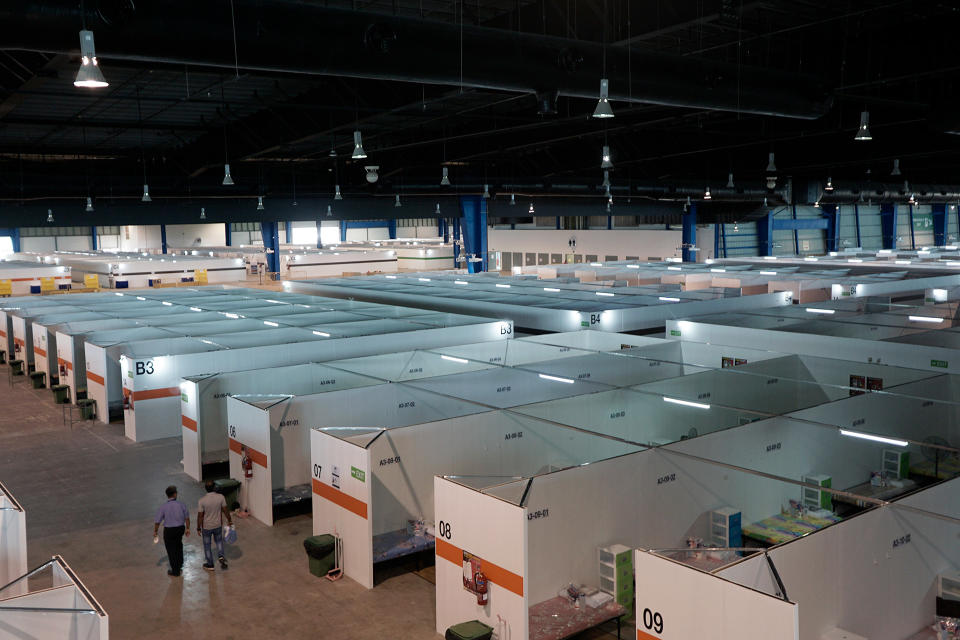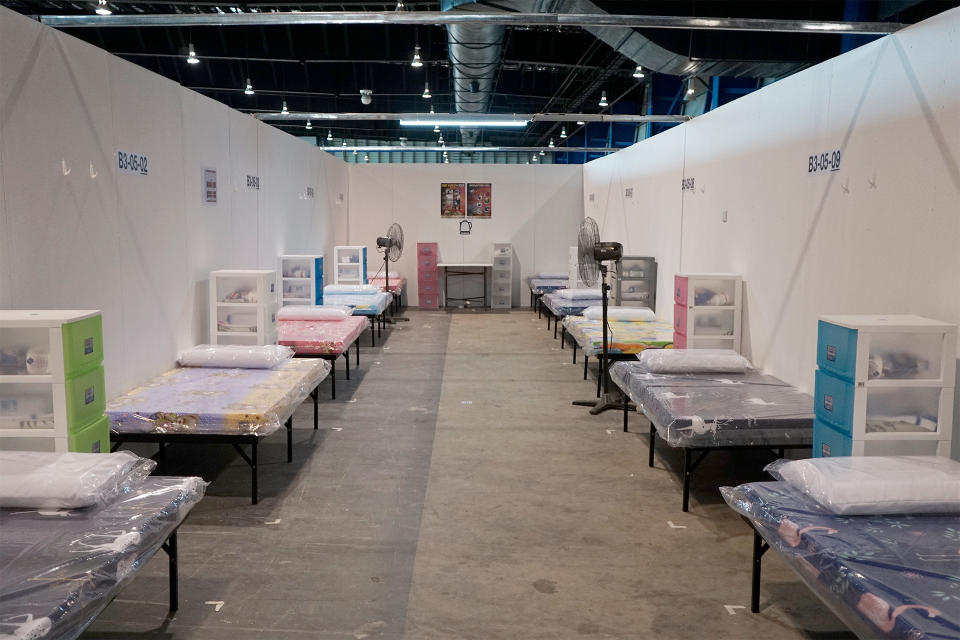COVID-19: Robots to help with operations at new Changi Exhibition Centre isolation facility
SINGAPORE — How does one care for thousands of COVID-19 patients while also minimising the chances of infecting the workers who are caring for them? Bring in the robots.
At the Changi Exhibition Centre (CEC), which has been repurposed as a community isolation facility for patients with mild or early symptoms, two different types of robots are currently in use — with a third being considered for deployment in the near future. These high-tech helpers will assist in communications with patients, the delivery of meals and, possibly, the dispensing of medication.
In its current state, a large portion of the CEC’s 33,000 sq m indoor space will be used to house some 2,700 people – mainly foreign workers from dormitories who are either recovering or early COVID-19 patients with mild symptoms. On Saturday (25 April), some 50 patients were transferred to the facility.
During a tour on Friday, members of the media were given a preview of the robots’ functions within the CEC.
First, to assist the on-site medical and facility staff with attending to patients’ needs while also minimising person-to-person contact, four remote-controlled BeamPro Telepresence Robots will be used to help with communications.
Through these devices, volunteers who are fluent in Bengali, Hindi, Marathi, Tamil and Telugu can virtually engage with patients in their native languages. Six teleconsultation stations are also available on-site while CEC staff will also tap on free translation apps to help in communicating with patients.



On top of this, there are also five STrobo Tug robots at the facility to help with the distribution of meals. Developed by ST Engineering, they will reduce the number of staff required within the CEC’s “red zone”, which is where the patients will be residing. There are plans to deploy up to 12 robots as CEC operations ramp up.
A third device being explored for use at the CEC is a four-legged robot called SPOT. Developed by Boston Dynamics and enhanced by the Government Technology Agency (GovTech), it is being mulled for use in delivering essential items such as medicine to patients, and for temperature taking.
“SPOT’s nimbleness, ability to avoid obstacles and criss-cross different surfaces, make it suitable to support operations in the environment of the CEC facility, performing tasks in areas that conventional wheeled robots cannot, such as in areas of uneven ground.
“SPOT can also carry up to 15kg of customised payload and can operate for up to 1.5 hours before recharge,” said GovTech in reply to queries from Yahoo News Singapore.
Facts and figures




With a 75,000 sq m of outdoor area under construction, the CEC will eventually house around 4,400 patients.
Managed by Mandarin Oriental, with healthcare services provided by Raffles Medical Group, the facility was set up in six days with help from 200 personnel from nine Ministry of Defence (MINDEF) affiliated organisations.
The CEC’s indoor portion is currently divided into three zones: “green”, “yellow” and “red”. The “red zone” incorporates the patients’ living areas, toilets, shower and laundry facilities, as well as a medical centre.
Only authorised personnel, such as medical workers and essential maintenance personnel, will be allowed into this zone and they will be required to don personal protective equipment (PPE).
Those entering and exiting the red zone, will pass through the “yellow zone”, which is where checks will be conducted to ensure that staff have donned their PPE correctly. Those exiting the red zone will also have all their personal belongings and equipment disinfected before they enter the green zone, which is where staff can work and rest without the need for PPE.
Within the red zone, patients will be housed in rooms, each accommodating eight to 10 people. Each room will also have power sockets, Wi-Fi access, fans and storage cabinets for personal items.
Patients will have 6 sq m of personal space, with bed spacing inside the rooms taking into consideration the existing social distancing requirements.
Professional services have also been engaged to conduct regular cleaning of the facility.
In terms of medical care, around 20 to 30 medical staff will be on hand during each of two daily shifts at the CEC. The amount of manpower deployed will also be scaled up according to the number of patients at the facility.
Blood pressure machines and pulse oximeters will also be placed around the patients’ living areas for them to conduct their own health checks three times a day. These readings, along with their temperatures, will be automatically submitted to the on-site medical team.
Emergency buttons will also be placed around the facility for patients, which will alert the operations and medical centres when activated, while a 24/7 emergency hotline is also available.
Patients who are deemed to have fully recovered and have tested negative for COVID-19 will be transferred out of the CEC facility.



In the area of welfare, patients will be provided with three Halal meals per day with a selection of Indian, Bangladeshi, Chinese and vegetarian options to cater for different dietary requirements.
Patients will also be given welcome kits that include items such as toiletries, laundry detergent, hand sanitiser, face masks and thermometers.
Given that most patients are likely to be foreign workers, a Telegram channel has also been created and will send out messages in various languages, such as Bengali and Tamil. With its name translating to “Second Home” – in Bengali, Tamil and Mandarin – the channel will organise daily virtual programmes, like exercise routines and entertainment.
Volunteers will also be able to send words of encouragement to the patients at the start and end of the day.
Through MediaCorp’s MeWatch video-on-demand service, patients will also have access to free ethnic content. They will also be able to redeem voucher codes for more content on StarHub Go, from channels such as Sun TV, Sun Music, Vaanathiral, Zee Cinema and Zee Thiral.
Stay in the know on-the-go: Join Yahoo Singapore's Telegram channel at http://t.me/YahooSingapore
More Singapore stories:
COVID-19: Stern warning for dorm which locked foreign workers in a room – reports
COVID-19: MOH suspends officer who leaked daily case updates, reviewing security protocol
COVID-19: Phoon Huat and RedMan shops to limit entry based on NRIC/FIN numbers from 25 April



